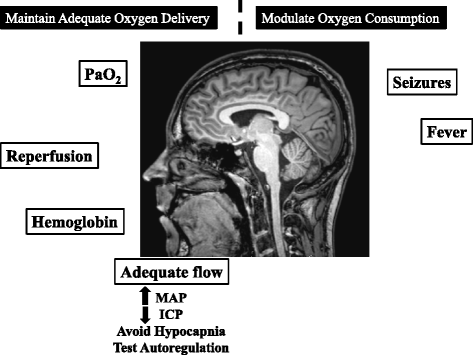Neuroprotection in acute brain injury: an up-to-date review
- PMID: 25896893
- PMCID: PMC4404577
- DOI: 10.1186/s13054-015-0887-8
Neuroprotection in acute brain injury: an up-to-date review
Abstract
Neuroprotective strategies that limit secondary tissue loss and/or improve functional outcomes have been identified in multiple animal models of ischemic, hemorrhagic, traumatic and nontraumatic cerebral lesions. However, use of these potential interventions in human randomized controlled studies has generally given disappointing results. In this paper, we summarize the current status in terms of neuroprotective strategies, both in the immediate and later stages of acute brain injury in adults. We also review potential new strategies and highlight areas for future research.
Figures

Similar articles
-
Understanding history, and not repeating it. Neuroprotection for acute ischemic stroke: from review to preview.Clin Neurol Neurosurg. 2015 Feb;129:1-9. doi: 10.1016/j.clineuro.2014.11.013. Epub 2014 Dec 3. Clin Neurol Neurosurg. 2015. PMID: 25497127 Review.
-
Experimental neuroprotection in ischemic stroke: a concise review.Neurosurg Focus. 2017 Apr;42(4):E2. doi: 10.3171/2017.1.FOCUS16497. Neurosurg Focus. 2017. PMID: 28366067 Review.
-
Neuroprotection and traumatic brain injury: theoretical option or realistic proposition.Curr Opin Neurol. 2002 Dec;15(6):707-12. doi: 10.1097/01.wco.0000044767.39452.bf. Curr Opin Neurol. 2002. PMID: 12447109 Review.
-
New approaches to neuroprotective drug development.Stroke. 2011 Jan;42(1 Suppl):S24-7. doi: 10.1161/STROKEAHA.110.592394. Epub 2010 Dec 16. Stroke. 2011. PMID: 21164111 Review.
-
Neuroprotection in acute ischemic stroke.Acta Neurol Belg. 2005 Sep;105(3):144-8. Acta Neurol Belg. 2005. PMID: 16255152 Review.
Cited by
-
The continuum of spreading depolarizations in acute cortical lesion development: Examining Leão's legacy.J Cereb Blood Flow Metab. 2017 May;37(5):1571-1594. doi: 10.1177/0271678X16654495. Epub 2016 Jan 1. J Cereb Blood Flow Metab. 2017. PMID: 27328690 Free PMC article. Review.
-
Serum biomarkers of delirium in the elderly: a narrative review.Ann Intensive Care. 2019 Jul 1;9(1):76. doi: 10.1186/s13613-019-0548-1. Ann Intensive Care. 2019. PMID: 31263968 Free PMC article. Review.
-
The effect of targeted hyperoxemia in a randomized controlled trial employing a long-term resuscitated, model of combined acute subdural hematoma and hemorrhagic shock in swine with coronary artery disease: An exploratory, hypothesis-generating study.Front Med (Lausanne). 2022 Aug 22;9:971882. doi: 10.3389/fmed.2022.971882. eCollection 2022. Front Med (Lausanne). 2022. PMID: 36072939 Free PMC article.
-
The effect of concomitant peripheral injury on traumatic brain injury pathobiology and outcome.J Neuroinflammation. 2016 Apr 26;13(1):90. doi: 10.1186/s12974-016-0555-1. J Neuroinflammation. 2016. PMID: 27117191 Free PMC article. Review.
-
Proteomic differences between focal and diffuse traumatic brain injury in human brain tissue.Sci Rep. 2018 May 1;8(1):6807. doi: 10.1038/s41598-018-25060-0. Sci Rep. 2018. PMID: 29717219 Free PMC article.
References
-
- Selassie AW, Zaloshnja E, Langlois JA, Miller T, Jones P, Steiner C. Incidence of long-term disability following traumatic brain injury hospitalization, United States, 2003. J Head Trauma Rehabil. 2008;23:123–31. - PubMed
-
- Tagliaferri F, Compagnone C, Korsic M, Servadei F, Kraus J. A systematic review of brain injury epidemiology in Europe. Acta Neurochir (Wien). 2006;148:255–68. - PubMed
-
- Roozenbeek B, Maas AI, Menon DK. Changing patterns in the epidemiology of traumatic brain injury. Nat Rev Neurol. 2013;9:231–6. - PubMed
-
- Hankey GJ. The global and regional burden of stroke. Lancet Glob Health. 2013;1:e239–40. - PubMed
-
- Zacharia BE, Hickman ZL, Grobelny BT, DeRosa P, Kotchetkov I, Ducruet AF, et al. Epidemiology of aneurysmal subarachnoid hemorrhage. Neurosurg Clin N Am. 2010;21:221–33. - PubMed
Publication types
MeSH terms
Substances
Grants and funding
LinkOut - more resources
Full Text Sources
Other Literature Sources
Medical

